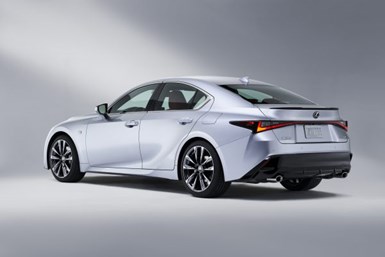Structural Engineering the 2021 Lexus IS
The compact sport sedan from Lexus is not just track-tested, but track-developed
#aluminum
“What we had foremost in mind in developing the new IS was to make it a car that excelled in communicating with the driver regardless of the road conditions or driving situation. We aimed to make the new IS a Lexus compact sports sedan that provides high-quality riding comfort while offering a high level of vehicle control.”
That’s Chief Engineer Naoki Kobayashi of Lexus International on the 2021 IS.

2021 Lexus IS. Designed and engineered to be driven hard. (Images: Lexus)
Where They Worked
To be sure, there are engineering facilities of an ordinary sort.
Then there is the Toyota Technical Center Shimoyama, which was opened in 2019.
Sort of think of it as a Japanese version of the Nürburgring Nordschleife, where Akio Toyoda has spent hours improving his driving skills.
Shimoyama is a 3.3-mile test course that includes a ~250-foot elevation change as well as an array of curves, corners, and road surfaces.
The RWD/AWD sport sedan is engineered to be driven—hard.
Addressing Mass
Which brought the engineers to the point of body rigidity. They increased it through means including reinforcing the radiator side supports, increasing the number of front-side-member weld points, and optimizing reinforcement structures from the C-pillars to the sides of the roof. A solid structure provides massive benefits.
And on the subject of mass, they greatly reduced it in a number of ways, even small ones like using hub bolts to secure the wheels to the car. This was something they learned from the Lexus LFA.
The use of hub bolts was a two-fer in that they increase the fastening strength and consequently have the rigidity that is required for hard braking and handling, but there was an elimination of two pounds of unsprung weight.
And following that path, they reduced mass in the suspension through the use of coil springs that are 20% lighter than the outgoing model’s; A-arms produced from a forged aluminum that makes them 18% lighter than the steel arms they replace; and a new suspension stabilizer bar that provides a 17% weight save.

Taut sheet metal over a rigid structure.
(For those of you wondering what powers the 2021 IS:
There are three engines:
- 2.0-liter four that produces 241 hp and 258 lb-ft of torque. It is mated to an eight-speed.
- 3.5-liter V6 that delivers 260 hp and 236 lb.-ft. of torque for an AWD version of the vehicle. There is a six-speed automatic. The electronically controlled AWD system distributes 30% of the torque to the front and 70% to the rear on dry roads; it can send up to 50% to the front wheels depending on conditions.
- 5-liter V6 that produces 311 hp and 280 lb.-ft. of torque. For RWD cars it has an eight-speed. For AWD it is the six-speed.)
RELATED CONTENT
-
The F-150 and Aluminum
As the launch of the 2019 Ram 1500 and the forthcoming release of the 2019 Chevy Silverado are heating things up in the full-size pickup truck segment, it is worthwhile to call out some materials engineering data related to the Ford F-150, the vehicle that, with the 2015 model year, arguably made a major shift in the segment because it was the vehicle that made the unthinkable a reality: a truck that uses aluminum for its body, box and other components.
-
Aluminum Sheet for EV Battery Enclosure
As the number of electric vehicles (EVs) is about to increase almost exponentially, aluminum supplier Novelis is preparing to provide customers with protective solutions
-
Volkswagen’s Remarkably Good Low Number
Last week Volkswagen announced two low numbers, one of which is actually really quite impressive.


.jpg;width=70;height=70;mode=crop)